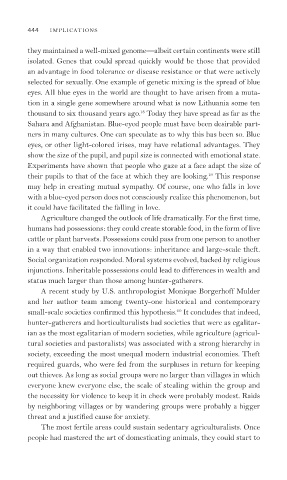Page 479 - Cultures and Organizations
P. 479
444 IMPLICATIONS
they maintained a well-mixed genome—albeit certain continents were still
isolated. Genes that could spread quickly would be those that provided
an advantage in food tolerance or disease resistance or that were actively
selected for sexually. One example of genetic mixing is the spread of blue
eyes. All blue eyes in the world are thought to have arisen from a muta-
tion in a single gene somewhere around what is now Lithuania some ten
18
thousand to six thousand years ago. Today they have spread as far as the
Sahara and Afghanistan. Blue-eyed people must have been desirable part-
ners in many cultures. One can speculate as to why this has been so. Blue
eyes, or other light-colored irises, may have relational advantages. They
show the size of the pupil, and pupil size is connected with emotional state.
Experiments have shown that people who gaze at a face adapt the size of
19
their pupils to that of the face at which they are looking. This response
may help in creating mutual sympathy. Of course, one who falls in love
with a blue-eyed person does not consciously realize this phenomenon, but
it could have facilitated the falling in love.
Agriculture changed the outlook of life dramatically. For the fi rst time,
humans had possessions: they could create storable food, in the form of live
cattle or plant harvests. Possessions could pass from one person to another
in a way that enabled two innovations: inheritance and large-scale theft.
Social organization responded. Moral systems evolved, backed by religious
injunctions. Inheritable possessions could lead to differences in wealth and
status much larger than those among hunter-gatherers.
A recent study by U.S. anthropologist Monique Borgerhoff Mulder
and her author team among twenty-one historical and contemporary
20
small-scale societies confirmed this hypothesis. It concludes that indeed,
hunter-gatherers and horticulturalists had societies that were as egalitar-
ian as the most egalitarian of modern societies, while agriculture (agricul-
tural societies and pastoralists) was associated with a strong hierarchy in
society, exceeding the most unequal modern industrial economies. Theft
required guards, who were fed from the surpluses in return for keeping
out thieves. As long as social groups were no larger than villages in which
everyone knew everyone else, the scale of stealing within the group and
the necessity for violence to keep it in check were probably modest. Raids
by neighboring villages or by wandering groups were probably a bigger
threat and a justified cause for anxiety.
The most fertile areas could sustain sedentary agriculturalists. Once
people had mastered the art of domesticating animals, they could start to

